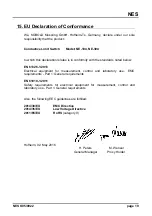
NES
page 12
NES K05/0922
8. Commissioning
Turn the sensitivity potentiometer fully clockwise to the right, until the stop is
reached.
When the mains voltage and the electrodes have been connected according to
their required function, the conductive limit switch is ready for operation. The tank
may now be filled. The sensitivity is optimally adjusted with this basic setting.
Should foaming cause the relay to operate too early, the sensitivity can be
reduced by turning the sensitivity potentiometer to the left, until the foam does not
cause the relay to operate.
9. Locating and Remedying Faults
The relay does not operate:
Check that the mains voltage is applied to terminals 1 and 2. If the voltage is
present, the red LED should light up and the relay should pick up. If there is no
reaction, the relay is faulty.
If the LED is energised
Relay NE-104:
Disconnect the electrode from terminals 14, 15, and 16, and
short-circuit terminals 14 and 15 with a wire jumper. The relay must drop out
now. If there is no reaction, the relay is faulty.
Relay NE-304:
Disconnect the electrode from terminals 10, 12, 13, 15, and 16,
and short-circuit terminals 10, 12 and 10, 15 with a wire jumper. The relay
must drop out now. If there is no reaction, the relay is faulty.
If the relay switches, remove the short-circuiting link and connect the
electrodes according to the connecting instructions. Short-circuit the electrodes
at the tips with a wire jumper. If the relay does not change over now, there is a
cable interruption, or the electrode tips are insulated by deposits.
If the relay with the wire jumper at the electrode tips changes over, remove the
wire jumper, adjust the maximum sensitivity on the relay, and immerse the
electrodes in the medium. If the relay still does not switch, the conductivity of
the medium may be too low.





































